The Underground Railroad
Until the 1830s antislavery supporters had been rather conciliatory. But a new type of anti- slaver—abolitionism—burst forth in 1831 when William Lloyd Garrison, a Bostonian, called for immediate and unconditional emancipation. The idea of immediate emancipation was not new (as early as 1824 Elizabeth Heydrick, an English abolitionist, had proposed it in a pamphlet),1 but it suddenly "caught on" during the "Age of the Common Man." Nearly simultaneously with Garrison's plea, men like Charles Grandison Finney and James G. Birney in the West called for the immediate abolition of slavery. There was suddenly abroad in the land what one historian has called "the anti-slavery impulse." 2
Garrison, as well as some Hoosier abolitionists, contended that slavery was both morally wrong and unlawful. Finney, most Quakers, and some Methodists, Baptists, and Presbyterians maintained that slavery was a violation of God's word; Birney and his followers assumed a political stance and asserted that slavery was unconstitutional. All factions agreed on most points, although they disagreed on the best way to abolish slavery.
The moral suasionist faction, although a very small minority, was perhaps the most active of all abolitionist groups--and certainly the most radical. They acted on the nation's conscience and tried to convince the country of the sinful and immoral nature of slavery. "There is a law above all the enactments of human codes," one Hoosier wrote; "it is written by the finger of God on the heart of man, and by that law, infinite and eternal, man can not hold property in man.''3 Moral suasionists pledged to obey this "higher law"--God's law and used illegal and legal means to achieve their goal. One way they espoused their cause was by means of the illegal system called the Underground Railroad.
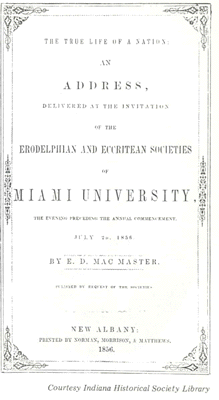
The metaphorical "Underground Railroad" is probably the best known aspect of the abolitionist movement. One chronicler called it "one of the greatest forces which brought on the Civil War and thus destroyed slavery.''4 No one knows exactly when or where the operation began. One theory is that Vestal Coffin and his wife, Aletha, founded it in Guilford County, North Carolina, and that the line they established ran to Indiana.5 Before the end of the Civil War, however, the "mystical" track traversed fifteen free states with crisscross lines that ultimately reached Canada.
Not an actual railroad, of course, this system transported escaping slaves in coaches, trains, steamships, and skiffs--though feet and wagons were the most common means of conveyance. Every home that welcomed fleeing blacks could be called a "station" on the Underground Railroad, and every person who guided them on their way became a "conductor." Those few who went south to seek out potential black "passengers," and led them to the free states and on to Canada, became "pilots" on the line.
Wilbur Siebert, a chronicler of the Underground Railroad's activities, wrote in 1898:It is quite apparent that the Underground Railroad was not a formal organization. A Terminology, it is true, sprang up in connection with the work of the Road, and one hears of stationkeepers, agents, conductors, and even presidents of the Underground Railroad, but these titles were figurative terms. The need of organization was not felt except in a few localities.6
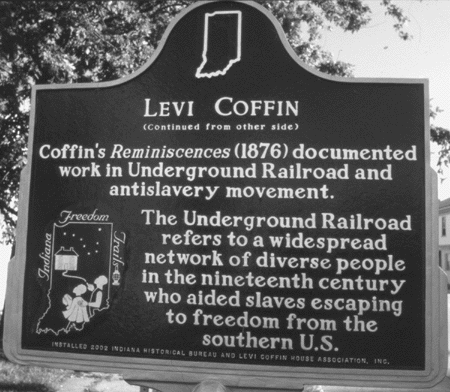
Levi Coffin Reproduced from Levi Coffin, Reminiscences
There are many legendary stories of how the Underground Railroad received its name, two of which relate to Indiana. One is that a Kentucky slaveholder coined the term in 1831. Tice Davids, a runaway, fled toward freedom while his slaveholder pursued him. Finally, Davids reached the Kentucky shore and dove into the Ohio River. As the escaping slave swam for his freedom, the slaveholder and his posse followed closely behind him in a skiff. Davids had barely come ashore when the slaveholder also touched land. The black man, however, had disappeared. The men searched the area for quite some time, but Davids had completely vanished. The baffled slaveholder then reputedly exclaimed, "He must have gone on an underground road.''7
Another version states that after seventeen black travelers hid in Levi Coffin's home in Newport, slave hunters came seeking them. The seventeen, however, were concealed in the garret behind the bed in Coffin's bedroom. The southerners' search was unsuccessful and one reportedly commented, "There's an Underground Railroad around here and Levi Coffin is its president.''8
Coffin, whose name is nearly synonymous with the Underground Railroad in Indiana, settled in Newport (now Fountain City) in 1826. "Soon after we located at Newport," he later recalled, "I found that we were on a line of the U.G.R.R." He noticed that fugitives often passed through the place with the help of local free blacks, but that some were recaptured and returned South. By his own admission, Coffin did not create the Underground Railroad in eastern Indiana--but he did organize it. Deciding to aid the black families in their effort, he "inquired of some of the Friends . . . why they did not take [fugitives] in and secrete them." By the winter of 1826-1827, fugitives began to arrive at the Coffin home, and it became widely known that fugitives could find shelter and food under the Quaker's roof. Later, Coffin became extensively known to the friends of the slaves.9
While Coffin offered his home and his help to fugitives once they reached Newport, he objected to anyone going into the South to lead them out.10 This attitude was not uncommon. "The operations of those in the North," a student of the Railroad in lndiana observed, "seldom led them south of the Ohio River; their policy being to assist the fugitive after he had made his escape and not to persuade him to run away.''11
Three principal routes ran north-south through Indiana. The western route commenced in Posey County, Spencer County (Rockport), or Vanderburgh County (Evansville). In Evansville the freedom seeker might emerge from the Ohio River and step along the "easy curving bend of the bank" where Charles McJohnston, who lived on Browning Road, Judge A. I. Robinson, Samuel McCutchan, or Willard Carpenter, the principal conductors in the area, might meet them. For some blacks, reaching Evansville offered freedom enough; the first black settled there in 1820.12 For most, Vanderburgh County was just the beginning. The lone or escorted fugitives would travel north through heavily wooded forests to Gibson County.
At Princeton, fugitives found a willing friend in the Reverend Thomas B. McCormick of the Presbyterian Church. McCormick, who reportedly piloted slaves out of the South, was so active in Gibson County that he later had to flee to Canada to avoid his own capture and arrest when the governor of Kentucky requested that he be extradited. Sarah Merrick, a white woman also of Princeton, had no time to escape to Canada for her role in helping fugitive slaves. After she had escorted a black woman and her three children from Henderson, Kentucky, Gibson County officials jailed Merrick in default of five hundred dollars bail.13
From Gibson County fugitives could go east off of the principal line into Pike County, where Dr. John W. Posey hid them in the area's coal mines or caves. Posey was so vigorous in his activities that the Methodist Church in Petersburg later dedicated a memorial stained glass plaque to him which reads:
"In memory of Dr. John W. Posey Friend to the Slave, Lover of the Union." In Pike County, when there was no danger of capture, the fugitives would be taken up the cane covered banks of the Patoka River; they would then go off on the Underground Railroad's splinter lines or resume travel on the principal line.14
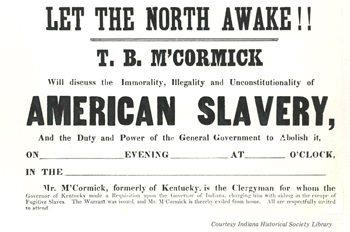
Courtesy Indiana Historical Society Library
From Princeton the principal line in the west continued along the Wabash River valley to Vincennes, Terre Haute, and Lafayette. At Lafayette, Dr. Luther Jewett was a prominent Railroad worker. Jewett, himself a persecuted Huguenot, hated oppression "in all its multiples." An acquaintance wrote in Jewett's obituary that "It was his pride in the early days of our slaveholding barbarism, when abolition was a stigma, to run the 'underground railroad.' " As the man remembered, "Many a poor slave fleeing from his cruel master, found succor under his hospital roof.''15 At times slaves would be taken to Attica, a short distance from Lafayette, where Quakers sheltered them, or they would be taken to the black settlement at Bethel. From the Lafayette area conductors transported fugitives to South Bend, where the welcome sight of the prairies foreshadowed the freedom that would be theirs. From northern Indiana, fugitives would travel to Niles, Michigan, or to Chicago, where Allan Pinkerton served as an Underground Railroad "agent" before he founded his detective agency.
The central route began in the vicinity of Brandenburg, Kentucky--at Leavenworth, Mauckport, Morvins Landing. In Indiana fugitives found refuge at Bill Crawford's, who lived near Corydon. His farm, which reputedly rested between the hills and hollows, was well adapted for concealing his freedom-seeking guests. From this point fugitives wended their way through Corydon and over the craggy hills to John Rankin's, fifteen miles north near Fredericksburg, on the New Albany and Paoli Pike. Conductors also transported fugitives from the mouth of Indian Creek in Corydon northeast across Jackson County or Jennings County and then continued north or veered to eastern Indiana and western Ohio.16
Thomas Hicklin, an active abolitionist in Jennings County, operated a station one half mile east of San Jacinto and piloted blacks to another station on Otter Creek in Campbell Township, and to a station at the home of John Vawter. Instead of continuing on, some fugitives remained in a black settlement southwest of Vernon.17
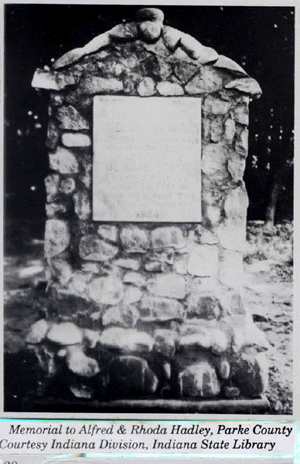
Memorial to Alfred & Rhoda Hadley, Parke County
Courtesy Indiana Division, Indiana State Library
The Mauckport Road, leading to Corydon, became known as the "seaport." This road joined another which led north to Salem, the county seat of Washington. Stephen Harding's home served as a stop in Ripley County; Leesville, Bloomington, and Columbus were also on the central route. In Bloomington, Samuel Gordon, who lived three miles south of the city, acted as an agent, as did Reverend James B. Faris and a black woman by the name of "Aunty Myears." Faris escorted the refugees on to Mooresville; they then traveled to rural Marion County and the home of Hiram Bacon. From Indianapolis some fugitives moved northwest through Crawfordsville or Rensselaer, sometimes on the way to Portage Township in Porter County, where Ben Cristman and Norman Tanner occasionally used their homes as Underground Railroad depots.18
The principal line in the east commenced at one of several points in southeast Indiana or in Ohio: Jeffersonville, Madison, Rising Sun, or Cincinnati. All these roads converged at Levi Coffin's home in Newport, north of Richmond. Coffin later claimed, "The roads were always in running order, the connections were good, the conductors active and zealous, and there was no lack of passengers." Fugitives from all points on the Ohio River were usually concealed at his house "until the blood hounds, in human shape, had lost the trail and given up the pursuit.''19
Madison was the site of some of the busiest Underground Railroad activity in the state. Robert Elliott, a teamster who lived some ten miles north of Madison, was one of the primary conductors in the area. Elliott, however, often found his wife's cousin, Robert Right Rea, a slave catcher in Madison and Jefferson County sheriff, to be a major obstacle. On one occasion, when Elliott boarded with Rea in Madison, he himself had to literally escape from Rea's home in the middle of the night before he could escort a group of runaways north of town.20
John B. Todd's house in Madison was also a stop on the Underground Railroad. Built in the 1830s the home had a special chimney constructed in it for the purpose of concealing fugitive slaves. Reportedly, however, Todd and Rea conspired to hold the fugitives to see if a reward were offered for their return; if so, they would turn them over to their slaveholder's and collect the money. If there was no reward, the slaves would be taken through Clifty Falls gorge up to Ryker's Ridge or up the Michigan Road.21
The Michigan Road ran from Madison to northern Indiana and, once there, the fugitives may have taken the Chicago to Detroit trace to either Illinois or Michigan. Following the Michigan Road from Madison to South Bend or Michigan City, the fugitives and conductors could also have veered off to La Porte, the "door" to the prairie, or to the northeast and Detroit. Also from Madison, slaves could travel to Brooksburg, Marble Hill, or Vevay, but the next main stop was in Union County at the home of abolitionist William Beard. Beard, of Salem in Union County, was just as active as Levi Coffin in Newport. Beard was so active that the women of the Henry County Female Anti-Slavery Society sent a part of all the material and clothing they made so that he could supply the numerous freedom seekers who came to his door.22 Apparently Beard forwarded many of the reputed 2,000 slaves Coffin is said to have sent to Canada. From Union County the self-emancipated slaves might go to various points in Decatur, Dearborn, Rush, Henry, and Wayne counties.
Thomas T. Newby of Carthage, in his recollections of his contribution to the Underground Railroad effort, remembered that runaways from Kentucky and Tennessee frequently patronized the route through Rush County. Newby pointed out, however, that agents exercised extreme care in transporting fugitives because "there were several men in Carthage who sympathized with the South and they were ever watching and ready to inform against any who aided a runaway slave." Despite the danger, a black agent named Burns piloted fugitives from Rushville to Carthage where another agent, either Jim Hunt or Elisha B. White, would take them to the Jessup station four miles north of Knightstown. Newby recalled that on one Sunday in 1855, as many as twelve slaves hid in his sugar orchard, safe from discovery because of the dense thicket.23
The fugitives who "rode" the Carthage route ended up going through Knightstown, Greensboro, Spiceland, Cambridge City, and other stops in Henry and Wayne counties until they reached Coffin's home in Newport. Coffin would then transfer them to agents who would take them to connecting lines leading to Canada.24 Jim Hunt, described as more venturesome than most, reportedly drove two fugitives north of Knightstown in his buggy one Sunday in the daytime.25 The conductors often dressed the fugitives in disguise.
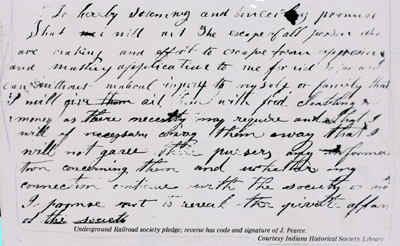
Underground Railroad society pledge; reverse has code and signature of J. Pearce.
Courtesy Indiana Historical Society Library
Transcription
I do hereby solemnly and sincerely promise that I will aid the escape of all persons who are making and effort to escape from oppressive and making application to me for aid so far as I can without material injury to myself or family that I will give them aid them with food clothing & money as there necessity may require and that I will if necessary convey them away that I will not give there pursers any information concerning them and whether any connection contrarie with the society or so I promise not to reveal the private affairs of the society
Westfield, in Hamilton County, was also an important "station," with fugitives arriving from Mooresville, Indianapolis, Lafayette, Darlington, Thorntown, and from various cities in Henry County and farther south. Many Quakers in the little village advocated antislavery and abolitionism. Once when the fugitive George Hoard and his wife and child found refuge in Westfield, their slaveholder traced them to the village. Nathan Hunt, a Quaker and a staunch antislavery supporter, appeared to assist the slaveholder; when the slaveholder spied the child and grabbed him, the Quaker reportedly admonished, "Thee put that child down, it is none of thine." Since Hunt supposedly held a stout stick and was prepared to strike, the slaveholder did as he was advised. 26
Wayne County had many contributors to the Underground Railroad effort. Apparently by the 1850s Wayne County conductors and agents formed a Society of Underground Railroad workers, with a membership pledge and code.27 From Richmond, but mainly from Newport, conductors took fugitives through Randolph and Jay counties to points east and west. In the east, splinter lines ran through Winchester, Marion, and Bluffton to Fort Wayne, then to Toledo, Ohio, and on to Canada. An alternative route was through Winchester, Marion, the Wabash-Huntington area, and Logansport. Addison Coffin, a transporter on the "line," wrote in 1844, "The Wabash line was in good running order and passengers very frequent."28
Eliza Harris, the slave mother immortalized by Harriet Beecher Stowe, reportedly stayed overnight at a station near Pennville in Jay County.29 Conductors also transported fugitives through Silver Lake, Goshen, and Bristol. Jesse Adams, Abner Blue, B. F. Cathcart, William Martin, and C. L. Murray acted as station keepers and conductors on the Bristol Road. The Murray home was the last stop in Indiana, only four miles from Michigan.30
Wilbur Siebert, considered a great authority on the Underground Railroad, is quite objective in his report of the activities of blacks in the operation. But "he does not," as one critic notes, "do . . . full justice to the contribution of blacks towards freeing their fellow-beings.''31 Neither do chroniclers of the movement in Indiana. Locally and nationally, free people of color identified with and aided those of their race who were enslaved. "The free people of color," the British reformer John Scoble observed, "are true to their brethren in bonds and are determined to remain by them whatever the cost." To the free blacks, slaves were their "brethren by ties of consanguinity, suffering and wrong."32
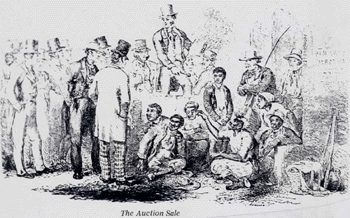
The Auction Sale
From Uncle Tom's Cabin, Volume I, facing page 174
Free blacks were among the few conductors who actually ventured to the southern states to lead the enslaved people to freedom. Some of the black pilots were ex-slaves themselves. "It was my great desire," William Wells Brown asserted after he seized his freedom, "being out of slavery myself, to do what I could for the emancipation of my brethren yet in chains." Also, slaves were more trusting and receptive to other blacks. As Brown observed, "The slave is brought up to look upon every white man as an enemy to him and his race.''33 Many blacks in Indiana helped their brethren in slavery, risking their own freedom and their lives to save their fellow beings in chains.
Chapman Harris, a free black resident of Jefferson County, was perhaps the most prominent Underground Railroad worker in the area. Harris, a blacksmith, devised an ingenious mode of communication to notify both other agents and slaves on the opposite shore of the Ohio River that he or his sons were about to row their skiff across and all who wanted to accompany them back were welcome. Outside his home at Eagle Hollow, three miles east of Madison, Harris placed an iron plate or anvil in the trunk of a sycamore tree; when the time came to go across the Ohio to pick up fugitives, he would hammer on the anvil.34
Harris was endangered at least twice during his activities as a pilot. Once, another black, John Simmons, also privy to information about the activities, made the nearly fatal mistake of divulging what he knew. Harris and a fellow black worker, Elijah Anderson, led a group of men who nearly whipped Simmons to death. Apparently the only thing that saved the informer's life was that he bit part of Harris' lip off. On this evidence, a judge of the circuit court in Jefferson County convicted Harris of the beating and fined him several hundred dollars.35
Anderson and another black worker, George De Baptiste, were virtually run out of Madison for their work on the Underground Railroad. De Baptiste continued his work in Detroit while Anderson continued his in Toledo, Ohio. Anderson, however, made periodic trips to Kentucky to rescue enslaved blacks. Finally caught and arrested while leading a group of blacks out of Kentucky, Anderson was subsequently sentenced to imprisonment in the Kentucky State Penitentiary at Frankfort where he died, mysteriously.36
George Evans, a free black who lived near Hanover, is credited with conducting slaves from Hanover to Decatur County as early as the 1830s. Henry Thornton, John Carter, and Griffith Booth were also active agents on the Underground Railroad in Jefferson County. Reportedly Booth's activities made it necessary for him to seek refuge in Canada in 1848, where he stayed until after the Civil War. Oswald Wright, Harrison County, was not as fortunate as Booth. As a result of his effort to help a fellow black escape slavery, a group of Kentuckians kidnapped Wright and his white accomplices, David and Charles Bell, and placed them in a Brandenburg, Kentucky, jail. Charles Bell's son rescued the two white men, but Wright was left behind and sentenced to a prison term.37
Miles Meadow, who ran a station just north of Kingston in Decatur County, was one of the most prominent workers in the area. James Shannon, another black, kept a vigil at Rising Sun, and escorted freedom seekers to Decatur County. William Thompson "was not only an expert in aiding fugitives to make good their escape, but he was one among the most active and successful conductors of the Underground Railroad." The Masonic lodge in Portland, on the outskirts of Louisville, planned daring escapes for fugitives. Near Terre Haute, in the black settlement in Lost Creek Township, the church served as an Underground Railroad station. Blacks in the Bethel Settlement, outside Attica, and at Delphi also guided and sheltered fugitives, as did Negro residents of Henry, Wayne, and Randolph counties.38 The contributions of these Underground Railroad workers--both black and white--were all the more commendable considering the repressive fugitive slave laws with which they had to contend.
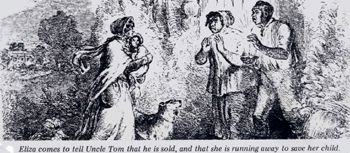
Eliza comes to tell Uncle Tom that he is sold, and that she is running away to save her child.
From Uncle Tom's Cabin, Volume I, facing page 62
